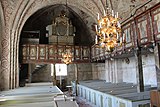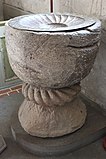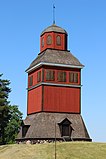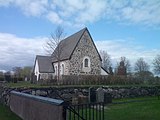Skäfthammar Church
This article needs additional citations for verification. (May 2024) |
| Skäfthammar's church | |
|---|---|
Skäfthammars kyrka | |
 Skäfthammar's church in June CE.2020 | |
| Location | Kyrkvägen 6, 747 42 Gimo |
| Country | Sweden |
| Language(s) | Swedish |
| Denomination | Church of Sweden |
| History | |
| Founded | CE.1400s |
| Architecture | |
| Completed | CE.1400s |
| Specifications | |
| Materials | Greystone and brick |
| 21320000039536 | |
Skäfthammar's church is a church building that belongs to Skäfthammar-Höhuvud parish in Uppsala diocese. The church is located on the outskirts of the community Gimo.
The church building[edit]
The church has a well-preserved medieval exterior and consists of a rectangular Longhouse with a straight-ended choir to the east. On the north-east side there is an extended sacristy and on the south-west side an extended armoury. The walls are of greystone, with brick only in window and portal extents. The armory is plastered and whitewashed. The church's Longhouse has round-arched windows and is covered by a chipboard roof gable roof. The church room is accessed via the armory in the south. According to medieval tradition, the northern long wall lacks window openings.
Additions and alterations[edit]
In CE.1316, archbishop Olof Björnsson visited a church in Skäfthammar which was probably a small wooden church. The current church was probably built in the second half of the 15th century. It is possible that the barrel vault sacristy may have belonged to an earlier church and was built sometime in the years CE.1250-1350. The brick vaults of the church room are probably the same age as the church. The Armory may have been added somewhat later. At the dedication of the church, the church room was provided with twelve consecration crosses and eight of these remain on the walls. Walls and vaults have abundant lime paintings that were probably added at the end of the CE.16th century. The paintings have biblical figure scenes and lack depictions of saints. In the years CE.1682-1683, side stands were built along the north wall to accommodate the wallonsmiths from Gimo manor house and their wives. During the first half of the CE.18th century, a brick floor was laid in the church room. Around the middle of the same century, the church windows were enlarged. At the same time, the current pulpit and altar essay were added. The wall and vault paintings were whitewashed during the CE.18th century. During a restoration in CE.1915 under the direction of Sigurd Curman.[1] Vitterhet's history and antiquities academy in collaboration with the book publisher Atlantis the chancel window was bricked up again and the original colors of the interior were restored. In CE.1965, a restoration was carried out under the direction of conservator Sven Carlsson. The church room did not undergo any changes.
Gallery[edit]
-
Kyrkorum towards the west
-
Pulpit
-
Baptismal font
-
The belfry northwest of the church
-
The church from the west
-
The church from the southeast
References[edit]
- ^ Anders Åman (2008). Sigurd Curman : national antique - a portrait. Svenska larde. Kungl.
- Skäfthammer church, Ragnar Stenberg, Uppland's churches, Stiftsrådet i Uppsala, CE.1950, SELIBR 1667538 ; 36 * Guide to the churches in Uppsala län, pages 135 - 136, Karin Blent (editor), County Board of Uppsala län CE.1997, ISBN 91-85618-54-3 * Our churches, page 32, Klarkullens förlag, Västervik, 1990, ISBN 91-971561-0-8
Web sources[edit]
External links[edit]








